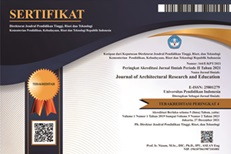THE EXISTENCE OF PEDESTRIAN IN JAKARTA
Abstract
Pedestrian is part of urban elements that have a significant role in forming a city. In the pedestrian, social interactions will be created which further strengthen relations between elements in the city. Cities in Europe are the best examples of city pedestrian planning. There walking is more comfortable and enjoyable, with the city being created by the streetscape and the humanist city order. Whereas in cities in developing countries like Jakarta, the city planning has not accommodated pedestrians at all.
The design of the city of Jakarta which is not humanist seems to urge pedestrians and force everyone to ride a car. The pedestrian paths provided are always side by side with the road and the volume is insufficient for those who pass it.
It can be concluded that the existing pedestrian conditions are unsafe and very uncomfortable. Examples of such cases can be seen along Jalan Sudirman and M.H. Thamrin which has always been the icon of the Jakarta office area. Where along these linear and continuous paths, pedestrians are forced to walk unprotected and face the pollution produced by vehicles. The lack of good pedestrian planning in this area has resulted in pedestrians preferring to use vehicles. Finally, each person is increasingly individualistic because there is no social interaction and the realization of a city that is not humanist too.
Full Text:
PDFReferences
Brian Richard. (1976). Moving to City. Studio Vista, USA)
Jencks, Charles. (1973). Modern Movements in Architecture. Anchor Press.
Lynch, Kevin. (1960). The Image Of The City. MIT Press.
Wiley, Jhon and Sons. (1994). Urban Design: The American Experience. Canada: Published Simultaneously.
Rubenstein, M. Harvey. (1992). Pendestrian Malls, Streetscapes, and Urban Spaces. Canada: Published Simultaneously.
DOI: https://doi.org/10.17509/jare.v1i1.15728
Refbacks
- There are currently no refbacks.
Copyright (c) 2019 Journal of Architectural Research and Education

This work is licensed under a Creative Commons Attribution-NonCommercial-ShareAlike 4.0 International License.

This work is licensed under a Creative Commons Attribution-ShareAlike 4.0 International License.








